![]() Reviewed By Joana Garrido DVM
Reviewed By Joana Garrido DVM
As a dog owner, you always want the best for your pup, and that includes choosing the right dog bowl. We’ve rounded up 5 types of popular dog bowls ranging from traditional plastic options to high-tech automatic feeders.
We will dive into each type’s unique features and benefits, so you can find the perfect fit for your pup’s specific needs.
1. Ceramic Dog Bowls
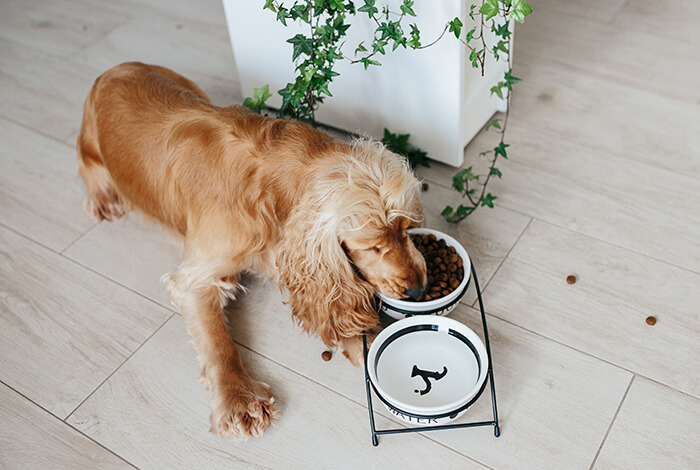
Ceramic Dog Bowl Pros
- Weighted bottom and high walls prevent sliding and food/water wastage
Ceramic dog bowls are quite hefty and have a weighted bottom. They are great for dogs prone to sliding their bowls around while eating.
Some heavy ceramic dishes have high walls and an inverted lip to prevent food and water wastage. These are suitable dog bowls for dogs that make a mess during mealtime.
- Glaze inhibits bacterial growth and makes cleaning easier
Ceramic dog dishes are furnished with a glaze, which hinders bacterial growth. The glaze also makes it easier to wash off leftover bits of dog food.
- Aesthetic appeal with various colors and designs available
If aesthetic appeal matters to you, ceramic dog bowls tick that box. They come in different colors and designs. Some are even handmade by skilled artists.
Ceramic Dog Bowl Cons
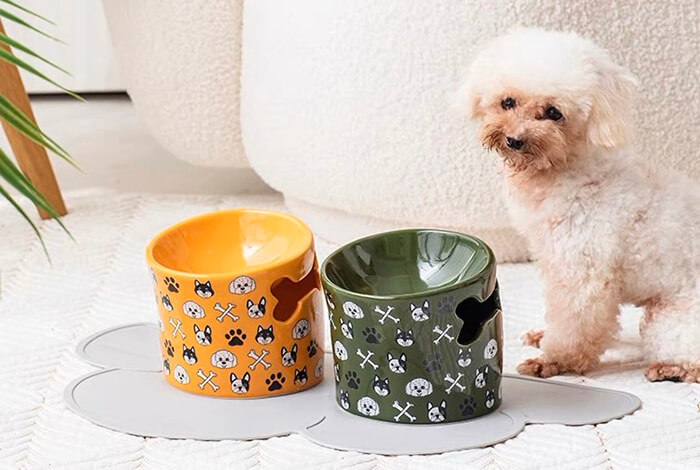
- Ceramic dog bowls can chip or break.
Although ceramic dog bowls are sturdy, they need to be handled with care. Accidental drops can break them into pieces, rendering them unusable.
In mild cases, it causes chips and cracks to form on the surface. Cracks and chips are convenient hideouts and breeding areas for bacteria.
The same thing may happen if a rowdy pooch roughly tips it over. Constant exposure to alternating hot and cold weather conditions causes a similar problem too.
Keep ceramic dog bowls in pristine condition by placing them in secure storage when not in use. Avoid using them for your furry pal’s outdoor mealtimes too. If you own a dog that loves tipping over his food bowls, consider looking for other alternatives.
- Ceramic dog bowls are not portable.
Dog dishes made out of ceramic are bulky. There is also the danger of shattering them by accident if you are not careful. These qualities make them inconvenient to bring when traveling with your canine companion. - Some ceramic dog bowls contain toxic glazes.
Certain types of ceramic glazes are laced with lead, which is extremely dangerous to dogs. Long-term lead exposure in dogs can negatively affect various organ functions including the heart, kidneys, and digestive system. Alarming side effects such as seizures and difficulty moving may occur.
Make sure that a ceramic dog bowl is lead-free by checking for a label that says so. If the product does not explicitly state “lead-free” or “leadless,” do not buy it.
Chances are high that the item did not undergo lead testing. Avoid ceramic dog dishes that are labeled with “for dog use only” for the same reason.
2. Stainless Steel Dog Bowls

Stainless Steel Dog Bowl Pros
- Highly durable due to the materials used.
Stainless steel dog bowls are made by mixing iron with carbon, nitrogen, silicon, nickel, and chromium. The combination of these materials makes them highly durable.
If dropped, a stainless steel dog dish will not sustain serious damage, like cracks. Some types even have rubber bases, which reduce spills and tipping. Moreover, the presence of chromium and nickel prevents rusts and scratches from quickly forming.
- Non-porous surface prevents harmful microbes from thriving.
Stainless steel dog bowls are non-porous, meaning harmful microbes cannot thrive on the surface. They are also easy to clean and dishwasher-safe.
- Some types have rubber bases to reduce spills and tipping.
To prevent spills and tipping from energetic pups, some stainless steel dog bowls come with a rubber base for added stability. However, it’s important to note that these types of bowls are typically not dishwasher safe.
Stainless Steel Dog Bowls Cons
- Not all stainless steel dog dishes are rust-resistant.
Certain metal dog bowls marketed as stainless steel are actually chrome-plated metals. They easily corrode and can leech iron oxide into your furry pal’s dog food.
For this reason, always inspect a dog dish for labels. It should clearly specify the type of steel used. To find rust-resistant stainless steel dog bowls, look for labels indicating the amount of chromium and nickel they contain.
The higher the percentage of nickel, the more immune it is to rusting. The best quality stainless steel dishes for dogs is 18/10. This means the bowl contains 18% chromium and 10% nickel.
- Some stainless steel dog dishes might be contaminated with toxic chemicals.
Back in 2012, two cargo containers carrying stainless steel pet bowls were recalled for being radioactive. The root cause was found to be Cobalt-60. It is a chemical commonly used for radiation therapy.
How this dangerous compound made its way to dog bowls due to cutting costs. Contaminated recycled medical equipment was used during the manufacturing process.
While this incident happened many years ago, one can never be too cautious. Avoid stainless steel bowls with warnings like “hand wash only” and “for pet use only.” They are likely made of low-quality materials.
Dog-safe stainless steel food and water bowls are made of food-grade stainless steel. The safest options you can find are metal dog dishes made from 304 or 316 stainless steel. They are commonly used for creating kitchen equipment and appliances.
3. Elevated Dog Bowls
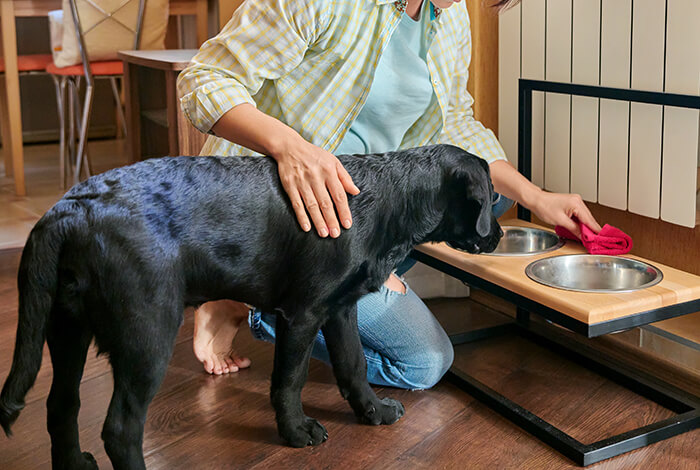
Elevated Dog Bowl Pros
- Elevated dog bowls are better for dogs with joint problems.
Is a raised bowl better for dogs with joint problems? Yes. It is an appropriate dog bowl for dogs with arthritis and other joint problems. The elevated height of a raised bowl encourages canines to eat in an upright position. Thus, dogs do not need to hunch down while taking their meals, which strains their neck and joints.
- Elevated dog bowls are great for long-eared dogs
Many pawrents ask: “What type of bowls are best for dogs with long ears?” Raised dishes are great dog bowls for long-eared dogs. Their elevated height prevents the ears of these canines from dipping into food and water. It minimizes the risk of ear infections, which long-eared dogs are highly susceptible to.
- Elevated dog bowls help dogs with megaesophagus
Another frequently asked question is: “Do elevated dog bowls help with digestion in dogs with megaesophagus?” The answer is yes. Megaesophagus is a condition in which a dog’s esophagus becomes too large and can’t push food and water down to the stomach as it should. This can happen because of a birth defect or an illness that develops later in life.
By using a dog bowl with a stand, both can travel more smoothly to the digestive tract. It is a suitable dog bowl for dogs with short snouts since they are predisposed to this ailment.
Elevated Dog Bowl Cons
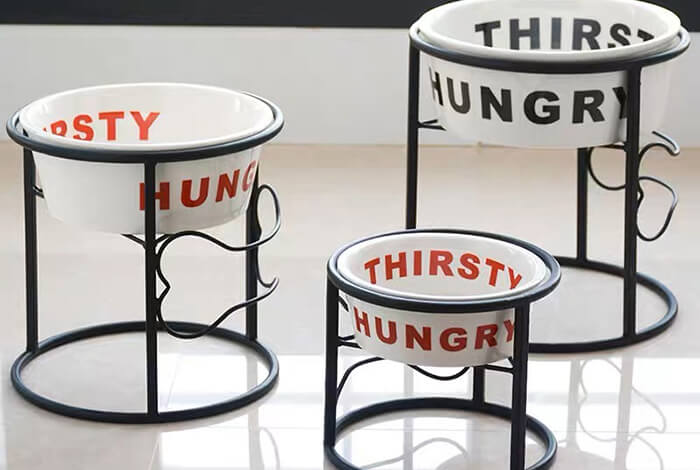
- Elevated dog bowls have unproven claims of reducing dog bloat.
Elevated dog bowls are believed to prevent dog bloat. It is said to keep dogs from taking in air as they eat, therefore minimizing the risk of this fatal condition.
However, studies about raised dog bowls have conflicting conclusions on dog bloat. Some researchers conclude that raised dog feeders do prevent bloat, while others refute this claim, saying it contributes to the manifestation of this health issue.
- Elevated dog bowls do not prevent messy eating.
Some claim that elevated dog bowls keep mealtimes mess-free as their weighted bottoms do not slide on the floor. However, on the contrary, raised dishes allow for spilling and wastage of food, just at a higher height. It is not the best choice for messy eaters.
- Food compartments in elevated dog bowls can cause problems.
Some raised dog dishes come with compartments where dog owners can store food. While this feature seems useful, it might bring more trouble than convenience.
Canines have a sharp sense of smell. They may attempt to break into the food compartment and cause serious damage to the elevated dog bowl, especially if they are large dogs.
4. Automatic Dog Feeder

Automatic Dog Feeder Pros
- Automatic dog feeders are programmable.
Automatic dog feeders have a standard dog bowl attached to a food container. As its name implies, this type of dog dish can be programmed to release a certain amount of dog food according to a set schedule.
- Pet feeders come with convenient features for when you are away.
Some automatic dog feeders can be accessed through smartphones and even have built-in pet cams. These features give dog owners the flexibility to change mealtime schedules when necessary and also monitor their canine companions. This type of dog bowl is great for individuals who are often away for most of the day.
- Automatic feeders are suitable for different types of dog food.
Most automatic feeders are primarily designed to store dry food. Since kibble sizes vary, some feeders were created to hold small kibbles, while others were intended for large kibbles. Some automatic feeders cater to holding wet food for dogs that are on this type of diet.
- Automatic feeders are suitable for multi-pet households.
If you have multiple pets in your household, automatic dog feeders with microchip readers are a great option. These feeders release food according to your pet’s unique microchip, ensuring that each pet gets the right amount of food.
Plus, if a different dog tries to access the feeder, it will automatically close, preventing food theft and ensuring that each pet stays on their designated diet.
Automatic Dog Feeder Cons
- Automatic dog feeders are not tamper-proof.
Highly food-motivated dogs may break into the automatic feeder to steal food. Avoid this issue by selecting the right size for your furry pal.
To know this information, read the dog bowl’s product description. It will indicate what size of dog it is designed for. Generally, standard-sized automatic feeders work for small dog breeds. But if you have a large breed of dog, go for a bigger feeder.
- Automatic dog feeders can have technical issues.
Just like any type of technology, automatic dog feeders can malfunction. Their dog bowls may get jammed while releasing kibble. Battery-operated products will fail to dispense food if they run out of power.
Automatic feeders that rely on electricity and Wi-Fi cannot function if there is a power outage or loss of signal. During these circumstances, dogs might end up missing meals and starving.
- Automatic pet feeders need monitoring
For this reason, always have a trusted person in your home to monitor your pet’s mealtime. Do not skip hiring a pet sitter or asking a close friend to keep an eye on him, especially if you will be gone for more than a day.
5. Slow Feeder

Slow-Feeder Pros
- Slow feeders prevent dogs from inhaling food.
Why are slow bowls good for dogs? A slow-feeder dog bowl has built-in obstructions like ridges that canines have to eat around. It is intentionally designed to prevent pets from inhaling their food quickly during mealtimes. This minimizes the propensity of dogs to develop bloat.
- Slow feeders stimulate mental stimulation.
The puzzle structures in the slow feeder dog bowl provide mental stimulation to your furry pal. Thus, this unique feature helps expend your dog’s energy and keeps his mind sharp while eating.
- Slow feeders prevent unwanted weight gain from overeating.
Using a slow feeder for your dog’s meals can benefit their weight control. Eating too quickly can cause overeating and weight gain, which slow feeders can help prevent. These feeders force dogs to eat at a slower pace, aiding digestion and promoting better weight management.
- Slow feeders help to contain the mess.
Feeding your dog on a slow feeder with an anti-skid bottom is a good idea to contain any mess. The dog dish keeps him from sloppily dropping food on the floor during mealtime.
- Slow feeders come with optional bowl inserts.
For pet owners who do not want to purchase a whole slow-feeder dog dish, go for a slow-feeder bowl insert. It is an accessory you place inside a normal dog bowl to turn it into a slow feeder.
Slow-Feeder Cons
- Slow-feeder dog bowls can be challenging to clean.
This type of dog dish has a more complex mechanism than regular bowls. It contains many nooks and crannies, which can be hard to clean depending on the design. In some cases, other parts need to be removed for thorough cleaning.
If you want an easy-to-clean slow feeder, choose products with one-piece puzzles. Avoid those that come with inserts as their crevices are harder to wash properly.
- Slow-feeder dog bowls are not suitable for all dogs.
Dogs have different levels of intelligence. Some are slower on the uptake than others. For these kinds of canines, they will initially require simple slow-feeder dog bowls such as those with ridges.
Introduce them to a more complex dog dish with inserts and flaps once he masters the easy slow feeder. If your furry pal is smart from the get-go, choose to use a dog dish with challenging puzzles. Otherwise, he will quickly figure out how to eat his food in a few gulps.
- Slow-feeder dog bowls cause difficulty in eating for certain dogs
The deep spaces of the slow feeder are hard to reach for brachycephalic dogs. They would need to strain their flat snouts to get food.
Their sensitive noses might get damaged when constantly pressed against the dog bowl. Thus, slow-feeder dishes are not ideal for them.
The 3 Dog Bowls to Avoid
1. Plastic Dog Bowls
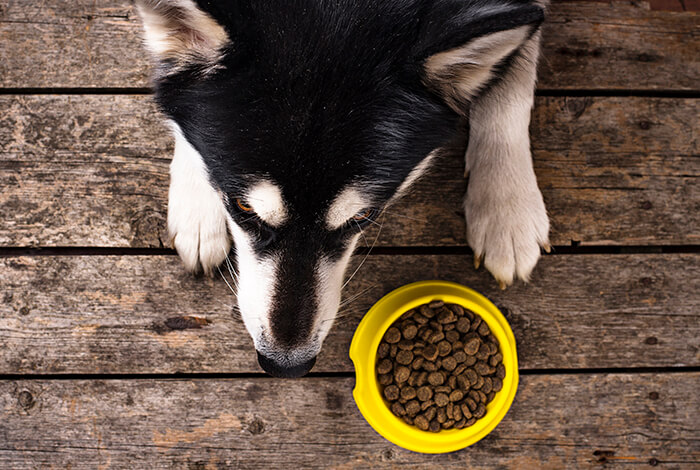
Plastic is one of the most inexpensive materials used to make dog bowls. But it should only serve as a last resort for dog owners if other options are not viable.
Plastic is linked to many health hazards to canines. It is microporous and can develop scratches over time, which cultivates the proliferation of harmful bacteria.
Some dogs suffer adverse reactions to plastic because of this risk. The microbes transfer to the skin upon contact, resulting in skin problems like chin acne or nasal dermatitis.
Shady manufacturers use cheap plastic containing bisphenol A (BPA) to create dog dishes. BPA is a dangerous compound that can affect your pet’s cognitive and heart functions. It increases his susceptibility to serious health issues like cancer.
Plastic dog water bowls must be kept away from canines too. It can leach BPA chemicals into the water and compromise their health.
2. Aluminum Dog Bowls

Aluminum dog bowls have a similar appearance to stainless steel dog dishes. But they pose a serious health risk to canines. The cumulative buildup of aluminum in your dog’s system can result in brain dysfunction and skeletal issues.
High-quality food-grade stainless steel dog bowls should not contain aluminum. So, make sure the dog dish is labeled aluminum-free.
Some argue that aluminum is typically anodized, a process that hardens the metal. This prevents it from leaching into dog food.
However, if the anodized aluminum has any scratches or damage, its harmful chemicals may seep into your pet’s meals. It must also be noted that the FDA did not give official approval for the use of anodized aluminum.
3. Gravity Dog Bowls
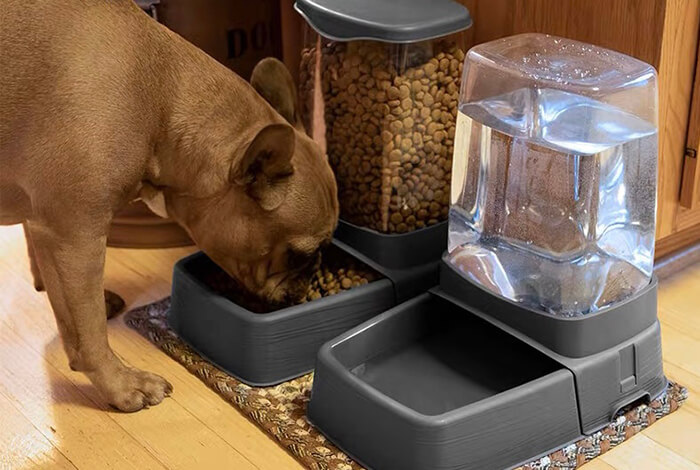
Some pet companies advertise gravity food bowls as automatic food dispensers for canines. But these products are different from each other. Automatic feeders give you control over when to dispense your furry pal’s meals.
On the other hand, gravity dog bowls function as storage for large amounts of dog food and water. Unlike automatic feeders, it is non-programmable. Hence, your pet’s meals are always on display, and he can eat them whenever he wants.
Using a gravity dog bowl to feed your dog encourages free feeding. Having constant access to food can lead him to gain weight and become obese, which is linked to several health complications like diabetes and arthritis.
Frequently Asked Questions About Dog Bowls
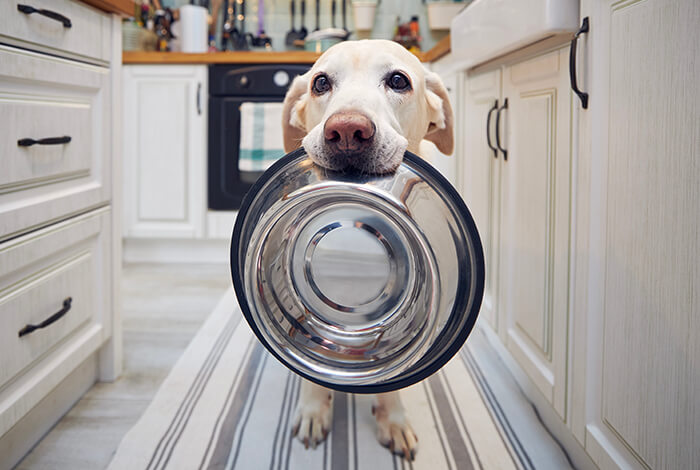
1. How often should I clean my dog’s bowls?
Ideally, dog bowls should be washed after every meal. Dog dishes with complicated mechanisms can be cleaned after feeding your pet the last meal of the day.
This applies to automatic feeders and slow feeders with complicated puzzles. However, if your dog is on a wet or raw food diet, aim to clean his food bowls before replacing it with fresh food.
2. Are dog bowls dishwashers safe?
Most dog bowls are dishwasher-safe. But just to be sure, look for the mark dishwasher-safe on the packaging. If there is no label, then assume that your pet’s food and water bowls should be hand washed only.
Dishwasher-safe dog bowls may harbor dangerous microbes like E. coli or Salmonella. They should be washed separately from your dinnerware to avoid cross-contamination.
The Final Deliberation

What are the best food and water bowls for dogs? Each dog has different needs. The best food and water bowl for some dogs might not be the most suitable for others. Thus, it is important to examine your pet’s eating habits to find the right dog dish.
For instance, if your dog is healthy and not a messy eater, you can get away with using stainless steel. Dogs with joint problems or long ears can benefit from elevated dishes. For messy eaters, a slow feeder or a ceramic bowl with high sides works best for them.
A dog’s eating habits can change over the years due to several factors like age and health. Do not be afraid to try other types of dog bowls we have on our list. Switching to the most appropriate choice will make mealtimes enjoyable for Fido and less stressful for you.

